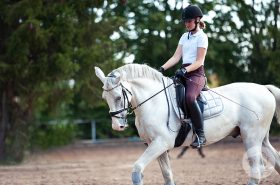I am often asked by students, “How can I get a stronger leg? I go to the gym multiple times a week, but I never feel as though my leg is strong enough to push my horse into a steady contact.” Have you, too, ever questioned your leg strength? I imagine every rider has asked themselves at some point during their riding career, so remember you are not alone in the struggle!

I remind students that many contributing factors play essential roles in creating the picture-perfect horse pushing into the rider’s hands. Riders should remember that leg pressure that is applied constantly using the same degree of pressure can teach a horse to ignore the rider’s leg ultimately. The horse begins to tune out the rider’s aids, so remember it is vital to keep your horse sensitive to your aids throughout the ride; ride every stride.
Pressures applied by the rider’s aids but in varying degrees assist in keeping horses listening or ‘on the aids.’ All riders should strive for awareness of their application, coordination, and timing of aids. This awareness allows the rider to effectively influence their horse responses using a softer seat, leg, and rein aids. During each training session, the rider should establish true forward from their leg with their horse. The horse should maintain a natural trot rhythm when the rider’s leg aid is applied in the driving rhythm.

The driving rhythm of the rider’s inside leg consists of increased leg pressure when the rider sits and a softer holding pressure when the rider rises during the rising trot. For example, drive, soften, drive, soften, etc. The increased pressure applied during each sit phase moment during the trot “fills up the gas tank,’ and keeps the horse’s energy forward without ever letting the horse fall behind the leg. Suppose the rider notices the horse did not push forward when the leg aid is applied. In that case, the rider should immediately correct the ignored leg aid used with a forward correction to their horse.

When the rider is in the rising phase at the trot, their leg is now in a ‘holding but softer leg pressure,’ not an increased driving leg pressure. Applying these similar principles while working the canter each stride will help riders push their horses into the contact in the canter gait, too.

Riders who have developed awareness of their horse’s responses will facilitate a training program that keeps their horse listening to softer aids when applied. Often riders wait too long before any corrections. If their horse has fallen behind the leg, riders usually feel they must become stronger with their leg to receive results. When leg pressure is applied, the horse must go forward immediately and not lag in a forward response. Riders with this level of competence will notice they receive the most significant results from their horse with little strength applied. A top dressage trainer once said, “sensitive horses must learn to be ridden with pressure or legs on, and lazy horses should be trained using very light pressure or legs off.” The rider’s goal ultimately is to receive the greatest results by using the lightest pressure of aids.

When the horses begin to put soft weight out into the rider’s hands, the rider can shape the horse of their inside leg and allow the horse to soften into the rein contact. At times a soft inside rein positioning and releasing by the rider while driving the horse forward with their leg in rhythm eventually assist in the horse stepping into an outside rein and softening into the rider’s hands.
Working different frames with the horse, such as stretching, working, and collecting frames, will help build proper topline muscle and help straighten a horse out, which makes a horse feel similar tracking both directions. This will straighten a horse, which leads to a properly balanced horse, and a pleasure to ride both on the flat and over fences.
Do you often feel the need you need to become stronger with your leg?
Love this blog post? We think you will like A Look at the Classical Pyramid of Training



